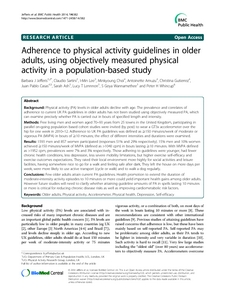Jefferis, BJ;
Sartini, C;
Lee, IM;
Choi, M;
Amuzu, A;
Gutierrez, C;
Casas, JP;
Ash, S;
Lennnon, LT;
Wannamethee, SG;
et al.
Jefferis, BJ; Sartini, C; Lee, IM; Choi, M; Amuzu, A; Gutierrez, C; Casas, JP; Ash, S; Lennnon, LT; Wannamethee, SG; Whincup, PH
(2014)
Adherence to physical activity guidelines in older adults, using objectively measured physical activity in a population-based study.
BMC Public Health, 14 (382).
ISSN 1471-2458
https://doi.org/10.1186/1471-2458-14-382
SGUL Authors: Whincup, Peter Hynes
![[img]](https://openaccess.sgul.ac.uk/107241/1.hassmallThumbnailVersion/Adherence_physical_activity_guidelines.pdf)  Preview |
|
["document_typename_application/pdf; charset=binary" not defined]
Published Version
Download (316kB)
| Preview
|
Abstract
BACKGROUND: Physical activity (PA) levels in older adults decline with age. The prevalence and correlates of adherence to current UK PA guidelines in older adults has not been studied using objectively measured PA, which can examine precisely whether PA is carried out in bouts of specified length and intensity.
METHODS: Free living men and women aged 70-93 years from 25 towns in the United Kingdom, participating in parallel on-going population based cohort studies were invited (by post) to wear a GT3x accelerometer over the hip for one week in 2010-12. Adherence to UK PA guidelines was defined as ≥150 minutes/week of moderate or vigorous PA (MVPA) in bouts of ≥10 minutes; the effect of different intensities and durations were examined.
RESULTS: 1593 men and 857 women participated (responses 51% and 29% respectively). 15% men and 10% women achieved ≥150 minutes/week of MVPA (defined as >1040 cpm) in bouts lasting ≥10 minutes. With MVPA defined as >1952 cpm, prevalences were 7% and 3% respectively. Those adhering to guidelines were younger, had fewer chronic health conditions, less depression, less severe mobility limitations, but higher exercise self-efficacy and exercise outcomes expectations. They rated their local environment more highly for social activities and leisure facilities, having somewhere nice to go for a walk and feeling safe after dark, They left the house on more days per week, were more likely to use active transport (cycle or walk) and to walk a dog regularly.
CONCLUSIONS: Few older adults attain current PA guidelines. Health promotion to extend the duration of moderate-intensity activity episodes to 10 minutes or more could yield important health gains among older adults. However future studies will need to clarify whether attaining guideline amounts of PA in spells lasting 10 minutes or more is critical for reducing chronic disease risks as well as improving cardiometabolic risk factors.
| Item Type: |
Article
|
| Additional Information: |
© 2014 Jefferis et al.; licensee BioMed Central Ltd. This is an Open Access article distributed under the terms of the Creative Commons Attribution License (http://creativecommons.org/licenses/by/2.0), which permits unrestricted use, distribution, and reproduction in any medium, provided the original work is properly credited. The Creative Commons Public Domain Dedication waiver (http://creativecommons.org/publicdomain/zero/1.0/) applies to the data made available in this article, unless otherwise stated. |
| Keywords: |
Older adults, Physical activity, Accelerometer, Physical health, Depression, Self-efficacy, Science & Technology, Life Sciences & Biomedicine, Public, Environmental & Occupational Health, PUBLIC, ENVIRONMENTAL & OCCUPATIONAL HEALTH, SCI, SEDENTARY BEHAVIOR, HEALTH, DISEASE, ACCELEROMETER, SCALE, RELIABILITY, HEART, AUSTRALIANS, LIFE, Public Health, 1117 Public Health And Health Services |
| SGUL Research Institute / Research Centre: |
Academic Structure > Population Health Research Institute (INPH) |
| Journal or Publication Title: |
BMC Public Health |
| ISSN: |
1471-2458 |
| Language: |
eng |
| PubMed ID: |
24745369 |
| Web of Science ID: |
WOS:000335499700001 |
| Dates: |
| Date |
Event |
| 2014-04-19 |
Published |
|
 |
Go to PubMed abstract |
| URI: |
https://openaccess.sgul.ac.uk/id/eprint/107241 |
| Publisher's version: |
https://doi.org/10.1186/1471-2458-14-382 |
Statistics
Item downloaded times since 20 Jan 2015.
Actions (login required)
 |
Edit Item |



